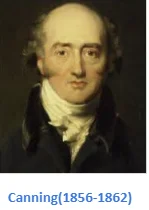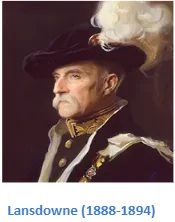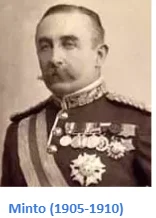The Government of India Act, 1858 laid the groundwork for future reforms and set the stage for the evolution of India’s administrative system. The Indian Councils Acts of 1861, 1892, and 1909 were key reforms in British India aimed at increasing Indian participation in governance. Following the 1857 Revolt, these acts progressively introduced Indians into legislative councils, expanded legislative functions, and established new representation systems. Each act represented a step towards greater political involvement and a more structured administrative framework in British India.

Government of India Act 1858 (Viceroy Canning)
Background: When the British Crown assumed sovereignty over India from the East India Company, the Parliament enacted the first statute for the governance of India under the direct rule of the British Government – the Government of India Act, 1858.

- This significant Act was enacted in the wake of the Revolt of 1857 – also known as the First War of Independence or the ‘sepoy mutiny’.
- The act, known as the Act for the Good Government of India, liquidated the East India Company and transferred the powers of Government, territories, and revenues to the British Crown. (India became a direct British colony.
Enroll now for UPSC Online Course
The provisions of this Act were as follows
- Liquidation of the East India Company: The Act resulted in the collapse of the East India Company and the transfer of control of Indian colonies to the British Crown.
- Governance in the Name of the British Queen: The Act stated that the British Indian possessions would be administered in the name of Queen Victoria, who would later become Empress of India.
- Introduction of the Secretary of State and Council: He was to be a member of the British Parliament and a member of the Prime Minister’s cabinet.
- The Secretary of State for India was in charge of communication between the British and Indian governments.
- The Secretary of State had enormous powers and could issue secret despatches to India without consulting the council.
- He was assisted by a council of 15 members.
- Scrapping of the Court of Directors and Board of Control: The powers previously held by the Company’s Court of Directors were transferred to the Secretary of State for India.
- Appointment of Governor-General and Viceroy: The Act established the positions of Governor-General and Viceroy, who functioned as the British government’s representative in India. To minimize problems, both jobs were united.
- Establishment of the Executive Council: The Viceroy was to be helped by an Executive Council in carrying out British India’s administrative tasks.
- Abolition of Dual Government and the Doctrine of Lapse: The Act repealed the Pitt’s India Act’s dual government system and removed the doctrine of lapse, which permitted the British to conquer states without a male heir.
- Introduction of Indian Civil Services: The Act provided for the foundation of the Indian Civil Services, which were tasked with administering the country.
- Indians were also permitted to join the military.
- Status of Indian Princes and Chiefs: Indian Princes and Chiefs’ Status: More than 560 Indian princes and chiefs were allowed to retain their independence as long as they recognized British suzerainty.
Limitation
- The Act of 1858 did not alter in any substantial way the System of Government of India.
Indian Councils Act of 1861 (Viceroy Canning)
Background: Following the significant uprising of 1857, the British Government recognized the need to involve Indians in the governance of their nation. In line with this strategy of collaboration, the British Parliament passed three acts in 1861, 1892, and 1909.
The provisions of this Act were as follows
- The induction of Indians into the Legislative Council marked the initiation of representative institutions. This involved the Viceroy nominating certain Indians as non-official members of his expanded council.
- In 1862, Canning, the Viceroy at that time, appointed three Indians to his legislative council: the Raja of Banaras, the Maharaja of Patiala, and Sir Dinkar Rao
- Decentralisation: The restoration of the Bombay and Madras Presidencies’ legislative authority marked the beginning of decentralisation.
- The centralizing trend that had begun with the Regulating Act of 1773 and peaked under the Charter Act of 1833 was reversed as a result of this.
- The devolution of legislative authority resulted in the provinces being granted almost total internal autonomy in 1937.
- Legislative Council: The introduction of new legislative councils was accompanied by the establishment of legislative councils for Bengal, North-Western Provinces, and Punjab. These councils were set up in 1862, 1886, and 1897, respectively.
- Portfolio System: It granted authority to the Viceroy to establish regulations and directives to facilitate smoother business transactions within the council. Additionally, it acknowledged the ‘portfolio’ system, first implemented by Canning in 1859.
- According to this system, a member of the Viceroy’s council assumed responsibility for one or more government departments and had the mandate to issue conclusive orders on behalf of the council concerning matters within their designated department(s).
- Ordinance powers: It granted authority to the Viceroy to promulgate ordinances without requiring the approval of the legislative council in times of emergency.
- This act vested the Governments of Bombay and Madras with legislative powers.
- The budget system was introduced in British India in 1860.
Significance: It introduced a grain of popular element insofar as it provided that the Governor-General’s executive council, which was traditionally comprised solely of officials, should now include specific non-official members when engaged in legislative activities as a legislative council.
Indian Councils Act of 1892 (Viceroy Lansdowne)
The provisions of this Act were as follows

- Increased Non-officials: It preserved the official majority in the Central and provincial legislative councils while adding more (non-official) members.
- Enhanced Legislative Functions: It empowered legislative councils to discuss the budget and ask questions of the administration after providing them with six days’ notice.
- Nomination of Non-Officials: It stipulated that the Viceroy, acting on the advice of the provincial legislative councils and the Bengal Chamber of Commerce, could nominate certain non-official members of the Central Legislative Council.
- The Governors could nominate members of the provincial legislative councils acting on the advice of district boards, municipalities, universities, trade associations, zamindars, and chambers.
- Election-related Indirect Provisions: The act established a restricted and indirect provision for the use of elections to fill a few non-official seats in the province and national legislative councils.
- The Act did not, however, contain the word “election.”
- The procedure was explained as a nomination submitted on specific bodies’ recommendations
Indian Councils Act of 1909 (Viceroy Minto)
This Act is also known as Morley-Minto Reforms (Morley was the then Secretary of State for India, and Minto was the then Viceroy of India).

- The provisions of this Act included the following:
-
- Increased Legislative Size: The Act significantly augmented the size of both Central and provincial legislative councils.
- The membership in the Central legislative council was raised from 16 to 60, while the number of members in provincial legislative councils varied.
- Retained Majority in Central: While maintaining an official majority in the Central legislative council, the Act permitted provincial legislative councils to have a non-official majority.
- Increased Functions: The Act expanded the deliberative functions of legislative councils at both levels. Members were granted the ability to pose supplementary questions, propose resolutions on the budget, and engage in similar activities.
- Association of Indians with Executives: It first introduced the association of Indians with the executive councils of the Viceroy and Governors.
- Satyendra Prasad Sinha made history as the first Indian to join the Viceroy’s executive council, serving as the Law Member.
- Introduced Communal Representation: The Act implemented a system of communal representation for Muslims by endorsing the concept of a ‘Separate Electorate.’
- Under this provision, Muslim members were to be elected exclusively by Muslim voters, thereby legalizing communalism.
- Minto gained recognition as the Father of the Communal Electorate.
- Additionally, the income qualification for Muslim voters was lower than that for Hindu voters.
- Increased Legislative Size: The Act significantly augmented the size of both Central and provincial legislative councils.
Enroll now for UPSC Online Course
-
- Separate Representation: The Act also mandated separate representation for presidency corporations, chambers of commerce, universities, and zamindars.
| Must Read | |
| Current Affairs | Editorial Analysis |
| Upsc Notes | Upsc Blogs |
| NCERT Notes | Free Main Answer Writing |
Conclusion
While the Government of India Act, 1858 established direct British control and introduced key changes, it also left many issues unresolved. Subsequent reforms, including the Indian Councils Acts of 1861, 1892, and 1909, sought to increase Indian participation in governance and address some administrative shortcomings. These changes marked the beginning of a gradual transition towards a more representative system in British India.
Sign up for the PWOnlyIAS Online Course by Physics Wallah and start your journey to IAS success today!
| Related Articles | |
| Council of Ministers and Cabinets | The Revolt of 1857 |
| The East India Company’s Rise in India | Government of India Act 1858 |

 GS Foundation
GS Foundation Optional Course
Optional Course Combo Courses
Combo Courses Degree Program
Degree Program











